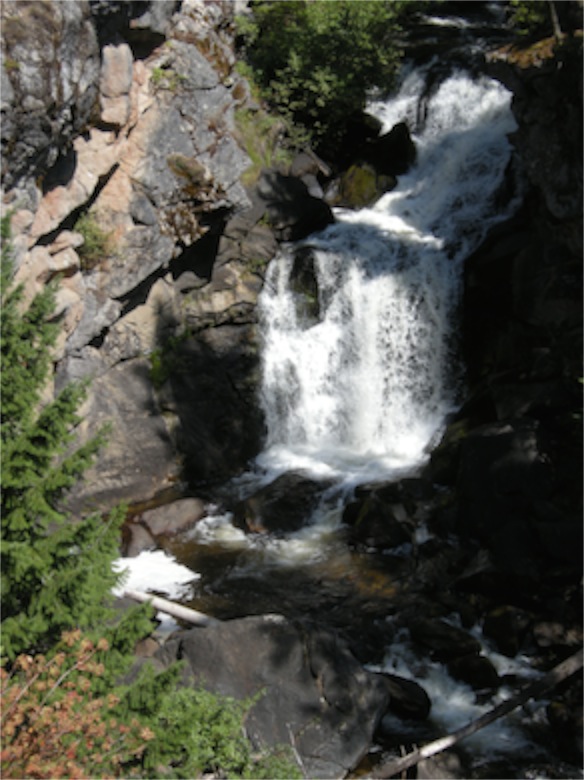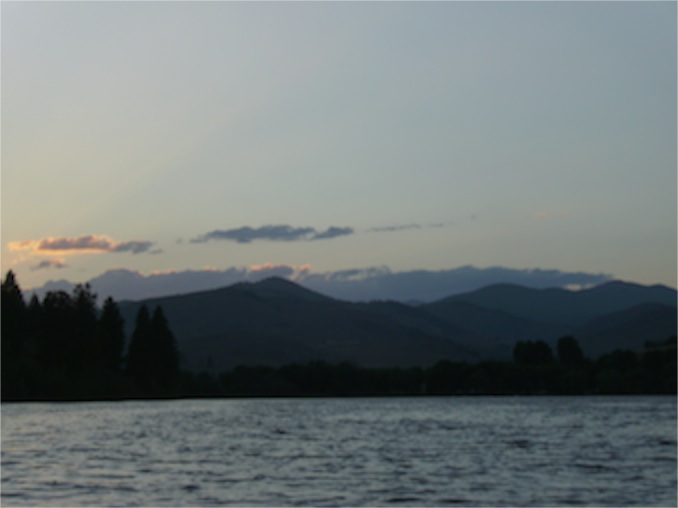Peace in the Valley
15/08/12 06:05
We’re camped at a small state park just out of Winthrop, Washington, this morning. We had a delightful drive through the mountains yesterday. With the exception of a short drive down the Okanagan valley, we spent the entire day driving in the mountains. The result is not the quickest or most direct route, but on vacation, speed and directness are not always the goals. In the years of driving across Washington, this is the first time we’ve taken this path. The western end of our drive, which we’ll pursue tomorrow, is the most northern route through the Cascades in the United States, over Stevens Pass. The highway in this area was only completed in the seventies, so it took a lot of thought and engineering before it was completed.
We’ve left the trail of Lewis and Clark far behind. They had an easy passage through the Cascades. The Nez Pierce helped them build canoes along the Snake River, which they followed to the Salmon and floated down the Salmon to the Columbia. The Columbia was flowing in its course before the mountains existed. The Cascades rose alongside the watershed, sometimes depositing magma into the river, but the river was not to be deterred. The volcanic mountains rose dramatically alongside the river. So the Corps of Discovery was traveling along a well-known river highway by the time they made it to the Cascades.
 The Cascades are dramatic and wonderful mountains, filled with waterfalls, glaciers, and dramatic vistas. Rising from nearly sea level, the peaks, many of which top 11,000 feet appear to be bigger than the mountains in other areas. In Montana, for example, the mountains rise from bases that are 4,000 feet above sea level. A 12,000 foot mountain in Montana is only about 8,000 feet of mountain above the plains.
The Cascades are dramatic and wonderful mountains, filled with waterfalls, glaciers, and dramatic vistas. Rising from nearly sea level, the peaks, many of which top 11,000 feet appear to be bigger than the mountains in other areas. In Montana, for example, the mountains rise from bases that are 4,000 feet above sea level. A 12,000 foot mountain in Montana is only about 8,000 feet of mountain above the plains.
Today will be a mix of wilderness and urban crush. I’m looking forward to the Wild Sky Wilderness Area – a new piece of territory for me. We expect to see snow and may even see some close enough to touch at the top of the pass. Our descent, however, brings us to the Interstate north of Seattle, which means that the quickest route to our destination is to drive through Seattle traffic. Interstate 5 is about the only route through the area and so all of the traffic has to squeeze onto the six or so lanes of traffic each direction. It will be a bit of a rude awakening after three days of driving on nearly empty highways.
We can already sense that the city lies beyond the mountains. The campground here is nearly full on a midweek night. There are campsites with three and four vehicles crammed together. I guess for city people a few feet between tents or RVs seems like a luxury of space. Their apartments probably share walls with the neighbors.
It isn’t fair for us to begrudge them the space in the campground. They have as much right to a vacation as we. They have as much right to space and air and water as we. Still we need to make a bit of an adjustment in our attitude to accommodate all of the people after spending several days in places that are lonelier.
 We arrived in time for a short paddle after dinner. It was good to get out on the water and stretch my limbs. I took out a kayak. I say that paddling a kayak is about the most natural form of exercise that I know. Each morning when I sit up in my bed, I stretch out my arms and make roughly the same motion as paddling a kayak. So I took an easy paddle to smooth out the kinds from driving most of the day. The sunset behind the Cascades was beautiful – more so than the pictures I took capture.
We arrived in time for a short paddle after dinner. It was good to get out on the water and stretch my limbs. I took out a kayak. I say that paddling a kayak is about the most natural form of exercise that I know. Each morning when I sit up in my bed, I stretch out my arms and make roughly the same motion as paddling a kayak. So I took an easy paddle to smooth out the kinds from driving most of the day. The sunset behind the Cascades was beautiful – more so than the pictures I took capture.
The east slope of the Cascades has one thing that is very similar to the east slope of the Rockies where I grew up: wind. The wind didn’t settle down until well after midnight last night. There weren’t any storms. It was just windy well after dark as the temperatures began to drop and things began to settle down. This side of the cascades is a whole lot drier than the other side. The precipitation tends to fall on the upslope as the moist Pacific air runs into the mountains.
I am eager for today. I’ll paddle as soon as it gets light and we’ll take our time winding through the cascades. The real treat, of course, will be getting to see our grandson, son and daughter-in-law. We say that our grandson has a powerful “tractor beam” that reaches out and attracts us. It is true that despite the wonderful technology that allows us to have video conversations, the longing to be together face-to-face is strong. Being with them is an important goal of this vacation.
Still, it has been good to have the time to unwind and explore the natural world. The medicine of mountain vistas and winding roads works wonders with me. I find myself able to sleep better and to let go of some of the day-to-day pressures that normally surround me. Except for a few places where our cell phone works, we haven’t had Internet connectivity since we left home. We have been staying in less-developed campgrounds without electric and water hookups. We have returned to the basics of cooking, eating and sleeping without dealing with our e-mail and other pressures. Of course, we aren’t totally “unplugged.” We have our cell phones and I have used my mobile hotspot to upload my blogs when I have a signal. We spoke on the phone to our office yesterday and we are aware of the most significant events since we left. And sometime today or tomorrow we’ll connect to the Internet at our son’s home and catch up on our communications.
For now, it is a very quiet morning on he east slope of the Cascades. The cricket song and a light breeze are the music that I hear. Today will be a busy day, but for the moment, peace reigns.
We’ve left the trail of Lewis and Clark far behind. They had an easy passage through the Cascades. The Nez Pierce helped them build canoes along the Snake River, which they followed to the Salmon and floated down the Salmon to the Columbia. The Columbia was flowing in its course before the mountains existed. The Cascades rose alongside the watershed, sometimes depositing magma into the river, but the river was not to be deterred. The volcanic mountains rose dramatically alongside the river. So the Corps of Discovery was traveling along a well-known river highway by the time they made it to the Cascades.

Today will be a mix of wilderness and urban crush. I’m looking forward to the Wild Sky Wilderness Area – a new piece of territory for me. We expect to see snow and may even see some close enough to touch at the top of the pass. Our descent, however, brings us to the Interstate north of Seattle, which means that the quickest route to our destination is to drive through Seattle traffic. Interstate 5 is about the only route through the area and so all of the traffic has to squeeze onto the six or so lanes of traffic each direction. It will be a bit of a rude awakening after three days of driving on nearly empty highways.
We can already sense that the city lies beyond the mountains. The campground here is nearly full on a midweek night. There are campsites with three and four vehicles crammed together. I guess for city people a few feet between tents or RVs seems like a luxury of space. Their apartments probably share walls with the neighbors.
It isn’t fair for us to begrudge them the space in the campground. They have as much right to a vacation as we. They have as much right to space and air and water as we. Still we need to make a bit of an adjustment in our attitude to accommodate all of the people after spending several days in places that are lonelier.

The east slope of the Cascades has one thing that is very similar to the east slope of the Rockies where I grew up: wind. The wind didn’t settle down until well after midnight last night. There weren’t any storms. It was just windy well after dark as the temperatures began to drop and things began to settle down. This side of the cascades is a whole lot drier than the other side. The precipitation tends to fall on the upslope as the moist Pacific air runs into the mountains.
I am eager for today. I’ll paddle as soon as it gets light and we’ll take our time winding through the cascades. The real treat, of course, will be getting to see our grandson, son and daughter-in-law. We say that our grandson has a powerful “tractor beam” that reaches out and attracts us. It is true that despite the wonderful technology that allows us to have video conversations, the longing to be together face-to-face is strong. Being with them is an important goal of this vacation.
Still, it has been good to have the time to unwind and explore the natural world. The medicine of mountain vistas and winding roads works wonders with me. I find myself able to sleep better and to let go of some of the day-to-day pressures that normally surround me. Except for a few places where our cell phone works, we haven’t had Internet connectivity since we left home. We have been staying in less-developed campgrounds without electric and water hookups. We have returned to the basics of cooking, eating and sleeping without dealing with our e-mail and other pressures. Of course, we aren’t totally “unplugged.” We have our cell phones and I have used my mobile hotspot to upload my blogs when I have a signal. We spoke on the phone to our office yesterday and we are aware of the most significant events since we left. And sometime today or tomorrow we’ll connect to the Internet at our son’s home and catch up on our communications.
For now, it is a very quiet morning on he east slope of the Cascades. The cricket song and a light breeze are the music that I hear. Today will be a busy day, but for the moment, peace reigns.